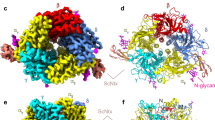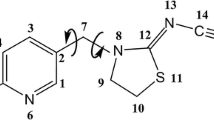Abstract
Models of the protein structure of agonist-, competitive antagonist-, and snake neurotoxin-binding sites were designed using the sequence of the first 54 residues of the acetylcholine receptor (AChR)α subunit from Torpedo californica. These models are based on the premise that the N-terminal portions of the subunits form the outermost extracellular surface of the AChR and that agonists bind to this portion. The models were developed by predicting the secondary strucutre of theα-subunit N-terminal segment from its sequence, then using these predictions to fold the segment into tertiary structures that should bind snake neurotoxins, agonists, and antagonists. Possible gating mechanisms and quaternary structures are suggested by the proposed tertiary structures of the subunits. Experiments are suggested to test aspects of the models.
Similar content being viewed by others
References
Anderson, D. J., and Blobel, G. (1980).In vitro synthesis and membrane integration of the subunits ofTorpedo acetylcholine receptor.Neurosci. Abstr. 6209.
Barrantes, F. J. (1974). The nicotinic cholinergic receptor: Different compositions evidenced by statistical analysis.Biochem. Biophys. Res. Commun. 62407–414.
Bartfeld, D., and Fuchs, S. (1979). Active acetylcholine receptor fragment obtained by tryptic digestion of acetylcholine receptor fromTorpedo californica.Biochem. Biophys. Res. Commun. 89512–519.
Beers, W. H., and Reich E. (1970). Structure and activity of acetylcholine.Nature 228917–922.
Blanchard, S. G., Quast, U., Reed, K., Lee, T., Schimerlik, M. I., Vandlen, R., Claudio, T., Strader, C. D., Moore, H. -P. H., and Raftery, M. A. (1979). Interaction of [125I]-α-bungarotoxin with acetylcholine receptor fromTorpedo californica.Biochemistry 181875–1883.
Carpenter, D. O., Swann, J. W., and Yarowsky, P. J. (1977). Effect of curare on responses to different putative neurotransmitters inAplysia neurons.J. Neurobiol. 8119–132.
Chang, H. W., and Bock, F. (1979). Structural stabilization of isolated acetylcholine receptor: Specific interaction with phospholipids.Biochemistry 18172–179.
Chou, P. Y., and Fasmen, G. D. (1974). Conformation parameters for amino acids in helical,β-sheet, and random coil regions calculated from proteins.Biochemistry 13211–245.
Chou, P. Y., and Fasmen, G. D. (1978). Empirical predictions of protein conformation.Annu. Rev. Biochem. 47251–276.
Cohen, F. E., Sternberg, M. J. E., and Taylor, W. R. (1980). Analysis and prediction of proteinβ-sheet structures by a combinatorial approach.Nature 285378–382.
Damle, V. N., and Karlin, A. (1980). Effects of agonists and antagonists on the reactivity of the binding site disulfide in acetylcholine receptor fromTorpedo californica.Biochemistry 193924–3932.
Edlestein, C., Kezdy, F. J., Scanu, A. M., and Shen, B. W. (1979). Apolipoproteins and the structural organization of plasma lipoproteins: Human plasma high density lipoprotein-3.J. Lipid Res. 2143–153.
Engelman, D. M., Henderson, R., McLachlan, A. D., and Wallace, B. A. (1980). Path of the polypeptide in bacteriorhodopsin.Proc. Natl. Acad. Sci. USA 772023–2027.
Feltz, A., and Trautmann, A. (1980). Interaction between nerve-released acetylcholine and bath applied agonists at the frog end-plate.J. Physiol. 299533–552.
Gonzalez-Ross, J. M., Paraschos, A., and Martinez-Carrion, M. (1980). Reconstitution of functional membrane-bound acetylcholine receptor from isolatedTorpedo californica receptor protein and electroplax lipids.Proc. Natl. Acad. Sci. USA 771796–1800.
Gund, P., Andose, J. D., Rhodes, J. B., and Smith, G. M. (1980). Three-dimensional molecular modeling and drug design.Science. 2081425–1431.
Guy, H. R. (1980). The coiled coil in a beta barrel: A model of the porin-lipoprotein complex ofE. coli outer membrane.Fed. Proc. 391832.
Heidmann, T., and Changeux, J. -P. (1978). Structural and functional properties of the acetylcholine receptor protein in its purified and membrane-bound states.Annu. Rev. Biochem. 47317–357.
Henderson, D., Eibl, H., and Weber, K. (1979). Structure and biochemistry of mouse hepatic gap junctions.J. Mol. Biol. 132193–218.
Karlin, A. (1969). Chemical modification of the active site of the ACh receptor.J. Gen. Physiol. 54245.
Karlin, A., Weill, C., McNamee, M., and Valderrama, R. (1976). Facets of the structures of acetylcholine receptors fromElectrophorus andTorpedo.Cold Spring Harbor Symp. Quant. Biol. 40203–210.
Karlsson, E. (1979). Chemistry of proteins in snake venoms.Hand. Exp. Pharmacol. 52159–204.
Kennedy, S. J. (1978). Structures of membrane proteinsJ. Membr. Biol. 42265–279.
Kimball, M. R., Sato, A., Richardson, J. S., Rosen, L. S. and Low, B. W. (1979). Molecular conformation of erabutoxin b: Atomic coordinates at 2.5 Å resolution.Biochem. Biophys. Res. Commun. 88950–959.
Klymkowsky, M. W., and Stroud, R. M. (1979). Immunospecific identification and three-dimensional structure of a membrane-bound acetylcholine receptor fromTorpedo californica. J. Mol. Biol.128319–334.
Kistler, J., and Stroud, R. M. (1981).Proc. Natl. Acad. Sci. USA. 783678–3682.
Levitt, M. (1979). Conformational preferences of amino acids in globular proteins.Biochemistry 174277–4284.
Lim, V. I. (1974). Algorithms for prediction ofα-helical andβ-structural regions in globular proteins.J. Mol. Biol. 88873–894.
Lindstrom, J., Merlie, J., and Yogeeswaran, G. (1979). Biochemical properties of acetylcholine receptor subunits fromTorpedo californica.Biochemistry 184465–4470.
Low, B. W. (1979). Three-dimensional structure of erabutoxin b, prototype structure of the snake venom postsynaptic neurotoxins: Consideration of structure and function; description of the reactive site. InAdvances in Cytopharmacology (Ceccarelli, B., and Clementi, F., Eds.), Raven Press, New York, pp. 141–147.
Low, B. W., Preston, H. S., Sato, A., Rosen, L. S., Searly, J. E., Rudko, A. D., and Richardson, J. S. (1976). Three dimensional structure of erabutoxin b neurotoxic protein: Inhibitor of acetylcholine receptor.Proc. Natl. Acad. Sci. USA 732991–2994.
Maelicke, A., Fulpius, B. W., Klett, R. P., and Reich, E. (1977). Acetylcholine receptor: Responses to drug binding.J. Biol. Chem. 254811–4830.
Mendez, B., Valenzuela, P., Martial, J. A., and Baxter, J. D. (1980). Cell-free synthesis of acetylcholine receptor polypeptides.Science 209695–697.
Moore, H. -P. H., Hartig, P. R., and Raftery, M. A. (1979). Correlation of polypeptide composition with functional events in acetylcholine receptor-enriched membrane fromTorpedo californica.Proc. Natl. Acad. Sci. USA 766265–6269.
Moore, W. M., Holladay, L. A., Puett, D., and Brady, R. N. (1974). On the conformation of the acetylcholine receptor protein fromTorpedo nobiliana.FEBS Lett. 45145–149.
Nelson, N., Anholt, R., Lindstrom, J., and Montal, M. (1980). Reconstitution of purified acetylcholine receptors with functional ion channels in planar lipid bilayers.Proc. Natl. Acad. Sci. USA 773057–3061.
Neubig, R. R., and Cohen, J. B. (1979). Equilibrium binding of [3H] tubocurarine and [3H] acetylcholine byTorpedo postsynaptic membranes: Stoichiometry and ligand interactions.Biochemistry 185464–5475.
Neubig, R. R., and Cohen, J. B. (1980). Permeability control by cholinergic receptors inTorpedo postsynaptic membranes: Agonist dose-response relations measured at second and millisecond times.Biochemistry 92770–2770.
Neubig, R. R., Krodel, E. K., Boyd, N. D., and Cohen, J. B. (1979). Acetylcholine and local anesthetic binding toTorpedo nicotinic postsynaptic membranes after removal of nonreceptor peptides.Proc. Natl. Acad. Sci. USA 76690–694.
Oswald, R. E., Wennogle, L. P., Saitoh, T., and Changeux, J. P. (1980). Structural aspects of the 66,000 dalton subunit of theTorpedo marmorata electroplaque acetylcholine receptor analyzed by limited proteolytic digestion.Neurosci. Abstr. 8252.
Raftery, M., Blanchard, S., Elliott, J., Hartig, P., Moore, H. -P., Quast, U., Schimerlik, M., Witzemann, V., and Wu, W. (1979). Properties ofTorpedo californica acetylcholine receptors.Adv. Cytopharmacol. 3159–182.
Raftery, M. A., Hunkapiller, M. W., Strader, C. D., and Hood, L. E. (1980). Acetylcholine receptor: Complex of homologous subunits.Science. 2081454–1456.
Ross, M. J., Klymkowsky, M. W., Agard, D. A., and Stroud, R. M. (1977). Structural studies of a membrane-bound acetylcholine receptor fromTorpedo californica.J. Mol. Biol. 116635–659.
Saitoh, T., Oswald, R., Wennogle, L. P., and Changeux, J.-P. (1980). Conditions for the selective labeling of the 6600 dalton chain of the acetylcholine receptor by the covalent non-competitive blocker 5-azido-[3H] trimethisoquin.FEBS Lett. 11630–36.
Schindler, H., and Quast, U. (1980). Functional acetylcholine receptor fromTorpedo marmorata in planar membranes.Proc. Natl. Acad. Sci. USA 773052–3056.
Smythies, J. R. (1980). Sterochemical evidence that the N-terminal 20 residue segment of theα-subunit dimer of the acetylcholine receptor protein contains the acetylcholine binding site.Fed. Proc. 391997.
Sternberg, M. J. E., and Thornton, J. M. (1978). Prediction of protein structure from amino acid sequence.Nature. 27115–20.
Tarrab-Hazdai, R., Bercovici, T., Goldfarb, V., and Gitler, C. (1980). Identification of the acetylcholine receptor subunit in the lipid bilayer ofTorpedo electric organ excitable membranes.J. Biol. Chem. 2551204–1209.
Tsernoglou, D., Petsko, G. A. (1976). The crystal structure of a post-synaptic neurotoxin from sea snake at 2.2 Å resolution.FEBS Lett. 681–4.
Tsernoglu, D., Petsko, G. A., and Hudson, R. A. (1978). Structure and function of snake venom curarimimetic neurotoxins.Mol. Pharmacol. 14710–716.
Unwin, P. N. T., and Henderson, R. (1975). Molecular structure determination by electron microscopy of unstained crystalline specimens.J. Mol. Biol. 94425–440.
Vandlen, R. L., Wu, W. C. -S., Eisenach, J. C., and Raftery, M. A. (1979). Studies of the composition of purifiedTorpedo californica acetylcholine receptor and of its subunits.Biochemistry 181845–1854.
Walkinshaw, M. D., Saenger, W., and Maelicke, A. (1980). Three-dimensional structure of the “long” neurotoxin from cobra venom.Proc. Natl. Acad. Sci. USA 772400–2404.
Weber, M., and Changeux, J. -P. (1974). Binding of Naja nigricolis [3H]-α-toxin to membrane fragments fromElectrophorus andTorpedo-electric organs. II. Effects of cholinergic agonists and antagonists on the binding of tritiatedα-neurotoxin.Mol.Pharmacol. 1015–34.
Zingsheim, H. P., Neugebauer, D. -C., Barrantes, F. J., and Frank, J. (1980). Structural details of membrane-bound acetylcholine receptor fromTorpedo marmorata.Proc. Natl. Acad. Sci. USA 77952–956.
Author information
Authors and Affiliations
Additional information
Supported by Armed Forces Radiobiology Research Institute, Defense Nuclear Agency, under Research Work Unit MJ 00032. The views presented in this paper are those of the author. No endorsement by the Defense Nuclear Agency has been given or should be inferred.
Rights and permissions
About this article
Cite this article
Guy, H.R. Structural models of the nicotinic acetylcholine receptor and its toxin-binding sites. Cell Mol Neurobiol 1, 231–258 (1981). https://doi.org/10.1007/BF00710680
Received:
Accepted:
Issue Date:
DOI: https://doi.org/10.1007/BF00710680




